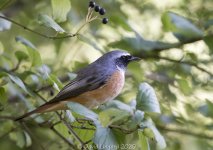dragnil
The glass is half full, but the bottle is empty.

A recent discussio about a Redstart at Flamborough prompts me to ask for help too. Despite many years birding, my experience of Redstarts is very limited and I saw this bird in the Prenees this autumn feeding happily on dogwood berries.
The Collins guide, however, doesn't show a pale wing panel or any white under the black bib. A search on line doesn't produce matches to my bird. Any guidance gratefully received.
David
The Collins guide, however, doesn't show a pale wing panel or any white under the black bib. A search on line doesn't produce matches to my bird. Any guidance gratefully received.
David





